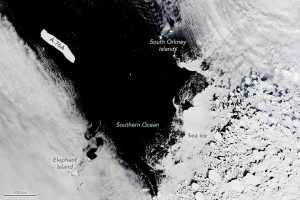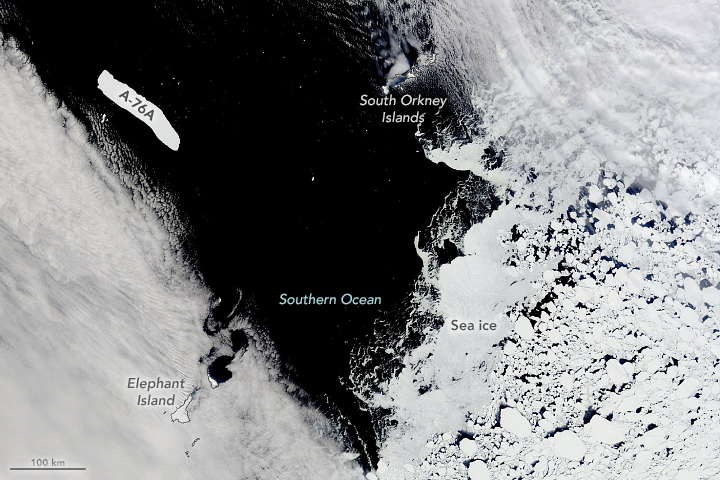
In October 2022, a clearing in the clouds revealed a huge, geometric piece of ice floating in the Drake Passage. This is Antarctic iceberg A-76A—the biggest remaining piece of what was once the largest iceberg floating in the world’s oceans.
In mid-May 2021, A-76, was, before it broke into three, the world’s largest floating iceberg, calved from the Filchner–Ronne Ice Shelf in Antarctica. The new iceberg, effectively a piece of floating ice shelf, detached from western side of the Ice Shelf.The iceberg is about 170 km (110 mi) long and 25 km (16 mi) wide, and is described as being “shaped like a giant ironing board”. The size at calving was an estimated 4,320 km2 (1,670 sq mi).
The new iceberg was first spotted by Keith Makinson, a polar oceanographer with the British Antarctic Survey in May 2021. By day 148, the iceberg consisted of three fragments, A-76a, (shown here) A-76b, and A-76c.
Another big berg is heading our way! A76a could be the second megaberg to enter the #SouthGeorgia Maritime Zone since 2020 and we are already seeing large amounts of ice in the water to the south of the island #iceberg #A76a @BBCAmos @BAS_News https://t.co/aTDUiddLdQ
— Government SGSSI (@GovSGSSI) March 2, 2023
The berg is visible in this natural-color image, acquired on October 31, 2022, with the Moderate Resolution Imaging Spectroradiometer (MODIS) on NASA’s Terra satellite. Notice the iceberg’s long tabular shape is distinct from the sea ice farther south in the Southern Ocean. (Icebergs are not sea ice; they are the floating fragments of glaciers or ice shelves, whereas sea ice is frozen seawater that floats on the ocean surface.)
The iceberg’s parent berg (A-76) broke from Antarctica’s Ronne Ice Shelf in May 2021. At the time, it was the largest iceberg anywhere on the planet. Within a month, the iceberg lost that status when it broke into three named pieces. The largest of those pieces—Iceberg A-76A—now drifts nearly 2,000 kilometers (1,200 miles) away in the Drake Passage. The passage is a turbulent body of water between South America’s Cape Horn and Antarctica’s South Shetland Islands, including Elephant Island visible in this image.
